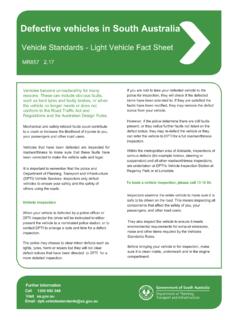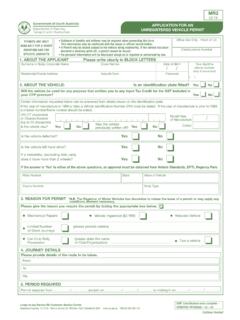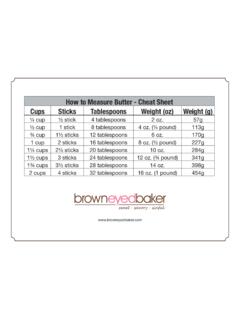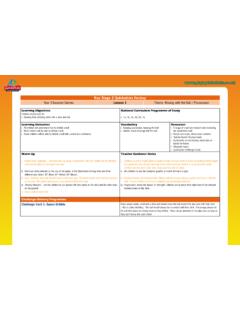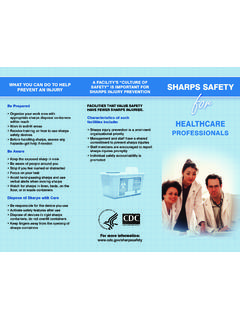Transcription of Walking Aids: using and measuring - SA.GOV.AU
1 Walking aids : using and measuring Walking aids can assist with balance, reduce fatigue or pain and facilitate a safe Walking pattern. Various sizes and styles are available and selection should be made based on the person's abilities, needs, environment and body shape. It is important that Walking aids are purchased or adjusted to the correct height and size. It is best to seek advice and training from a health professional before making a selection. Crutches Underarm (axilla) crutches are commonly used following an acute, short-term injury and may be recommended for those who are only able to bear weight on one leg.
2 Forearm (or elbow) crutches may not be quite as stable with a full load and are commonly recommended in situations of long-term use for those who can bear weight on both legs, but who require the additional support. When using crutches, weight should be taken through the hands via the hand pads. For underarm crutches, the top pad of the crutch should be pressed against the side of the chest wall (approximately 5cm under the armpit). It is important that the crutches are not positioned high against the armpit as this can cause damage to nerves and blood vessels located close to the skin and can also affect posture, balance and stability.
3 Crutches should be positioned slightly to the side and forward of the body for a stable base of support. To set the correct height of underarm crutches, place the top axilla pad approximately 5cm (2 3 finger widths) under the armpit and extend the crutch to a point on the ground approximately 15cm out from the side of the foot. In this position the handgrip should then be adjusted to sit approximately at the height of the wrist crease. This should allow for around 15 30 degrees of bend at the elbow. For elbow crutches, measure the handle height as with underarm crutches. To set the height of the forearm cuff, measure from a clenched fist to below the elbow crease.
4 The forearm cuff should not impede upon elbow movement but should stop the crutch from slipping off the arm. There are many different ways to use crutches depending on balance and the ability to place weight on one or both legs. If the affected leg can hold some body weight, then it is recommended that the crutches and the affected leg be placed forward together approximately one step length (sharing the load between them) followed by the unaffected leg. Another option is to use a four point Walking pattern, which is slower but may assist with safety for general weakness. Page 1 of 4. This involves putting one crutch forward, then the opposite leg, and then the next crutch forward, followed by the final leg and continue with this pattern.
5 If balance is poor and no weight can be taken on the affected leg, then it is suggested that both crutches be put forward first, followed by a hop forwards of the unaffected leg, stopping just behind the crutches and keeping the affected leg clear of the ground. If balance is good then the hop can swing past the level of the crutches, which will increase speed and fluency. To climb up stairs and steps, lift the unaffected leg up to the step first while taking weight on the crutches, and then bring the crutches and the affected leg onto the step second. To go down, lower the affected leg and the crutches down the step first followed by the unaffected leg second.
6 Walking Sticks, Quad Sticks and Tripods Walking sticks provide a basic level of support and are designed to assist with balance and/or decrease weight on an affected leg. A range of handle styles are available including t-shaped, crook, swan neck, offset, and contoured handles (or arthritic handles), which are designed to provide additional support under the palm. Sticks can be made from wood, steel or aluminium and may be available in a fixed or adjustable length. Wooden Walking sticks should not be stored in direct sunlight or in a damp environment to avoid swelling and cracking. Three and four-point sticks (also known as tripods and quad sticks) provide a wider base of support than the more common single point Walking stick, however, they can also create a potential tripping hazard due to their increased side width and it is important to discuss this choice with a health professional.
7 To measure the height of Walking sticks, quad sticks and tripods, the base of the stick should be placed approximately 15cm from the outside of the foot and the handle height should be set at the wrist crease height. The elbow should be bent slightly (generally between 15 and 30 degrees) when holding the stick and standing upright. Walking sticks are usually used on the unaffected or strongest side of the body but this may depend on individual preference and abilities. The stick should be placed forward at the same time as the affected leg and then the unaffected leg follows. If using two sticks at the same time, a four-point gait may be used by bringing one stick forward, then the opposite leg, then the other stick, followed by the other opposite leg.
8 Three or four point sticks with an offset base should be positioned so that the straight side of the base is nearest to the body. All points of the stick should maintain contact with the ground when the stick is placed down. To negotiate going up steps and stairs, lift the unaffected leg up first, then the stick and the affected leg onto the same step. To travel down, the stick and the affected leg should be lowered first, then the unaffected leg down to the same step. Walking Frames Three or four-wheeled Walking frames Three or four-wheeled walkers provide more support than Walking sticks and are designed for users who can walk reasonably well but who would benefit from extra support over longer distances.
9 Three-wheeled walkers are easy to manoeuvre but Page 2 of 4. are less stable than four-wheeled models (which have a larger base of support) and are therefore rarely recommended. Wheeled Walking frames are generally designed for both indoor and outdoor use and feature either bicycle-style hand brakes or push down brakes. Bicycle-style hand brakes feature levers that can be squeezed upwards to brake temporarily or pushed down to lock into place. Push down brakes work by pushing down through the handles which then pushes a spring-loaded rubber stopper, (located between the twin castor rear wheels), down onto the ground.
10 When weight is removed from the handles the brakes will spring off. It is important to practice operating the brakes before selecting a walker. When adjusting the height of a Walking frame it is important to wear everyday shoes and stand in a natural position with hands resting comfortably to the sides of the body. In this position, the Walking frame handgrips should sit approximately at wrist crease height. Four-wheeled walkers often come with a seat that is fixed in height so it is important to check that this is appropriate before making a purchase. When sitting on the seat in a comfortable position, feet should be resting flat on the ground.




